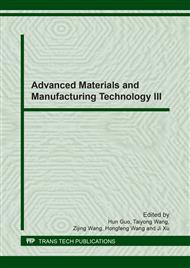p.115
p.123
p.133
p.142
p.156
p.164
p.174
p.184
p.194
Quantitative Study on Abrasive Belt Wear Based on Geometric Parameters
Abstract:
In this paper, based on micro wear form, an approach that using protrusion height, average tool angle, blunt area ratio and coated density to describe the wear of abrasive belt is put forward. The method for calculating the above parameters are also introduced. In experiments, we use the profilometer to collect the abrasive belt surface data and draw figures of the above parameters under service time, which indicates that using topography parameters can describe the degree of belt wear. According to parameters changing slope, the abrasive belt service time is roughly divided into two stages, initial wear stage and stable wear stage but no abrupt wear stage. Initial worn stage grains suffer more stress, patterns of wear are mainly severe wear and pull-off, while stable wear stage grains bear less stress and pattern of worn is dominated by mild wear. In addition to that, the other parameters changing trend is agreed and synchronous with protrusion height.
Info:
Periodical:
Pages:
156-163
Citation:
Online since:
February 2018
Authors:
Price:
Сopyright:
© 2018 Trans Tech Publications Ltd. All Rights Reserved
Share:
Citation:


